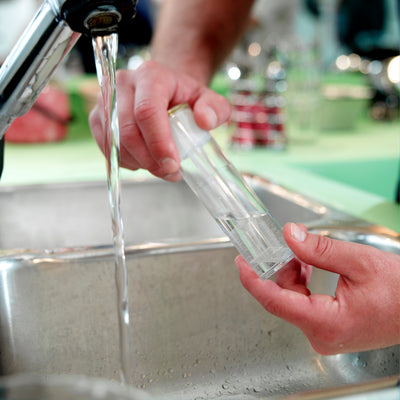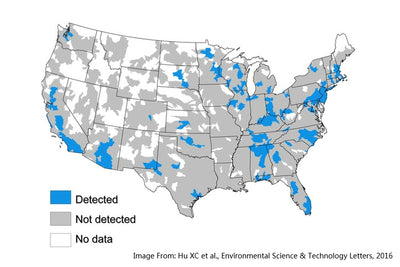There has been some major news coverage about "GenX" and other pre GenX perfluoroalkyl/polyfluoroalkyl substances (PFAS) contamination in North Carolina and throughout the entire country. The Environmental Working Group (EWG) just published a list of new PFAS-effected communities, which includes an extensive list of new cities. If you'd like to check out the map, you can find it linked here. Whenever something like this makes it into the news, the facts can quickly become obscured, so the aim of this article is to summarize a few key things to know about GenX and other PFAS in drinking water. If you're curious about water filter that remove PFAS (including GenX) from tap water, check out this Duke/NC State PFAS study.
What Is GenX?

GenX is a trade name for a chemical (deduced structure shown above) that went into production around 2010 as an alternative to a perfluorooctanoic acid (also known as PFOA or C8) in the synthesis of PTFE (ie Teflon). PFAS is the broad category in which GenX, PFOA, and PFOS fall under. PFAS are essential for the production of common household products including non-stick pans, firefighting foam, and common outdoor fabrics (e.g. Gore-Tex).
Why Do We Care About GenX And Chemicals Like It?
It's pretty simple: 1) These chemicals are known to be toxic (and this link too) 2) They are persistent in the environment, which means that they don't break down, and can contaminate water far from the contamination source.
Is GenX or Other PFAS Regulated By EPA?
No. Which means that there are no regulatory limits, and municipalities are not required to test for it. There are a lot of chemicals that fall into this category.
Why Is This Such A Big Problem In North Carolina?
A company called Chemours (which was originally spun out of Dupont) produces GenX at a plant in Fayetteville, NC. Discharge from this plant contaminates the Cape Fear watershed.
Are There "Safe" Levels of GenX And Other PFAS In Drinking Water?
Remember, while it's uncomfortable to think about chemicals of any kind existing in drinking water at any concentration, we try and remind people that the dose makes the poison. The example that we like to use is that drinking seawater will kill you from the high salt levels, but putting a pinch of salt in your soup broth is completely fine. The same is true for any chemical. The most credible information that exists at this time on toxicity of PFAS comes from a toxicological profile done by US Center For Disease Control (CDC). In this report, CDC establishes a health advisory level of 20 parts per trillion for the cumulative sum of all PFAS in drinking water, using lifetime exposure levels.
How To Filter GenX And Other PFAS From Drinking Water
If you live in an area that has PFAS levels over the CDC's Health Advisory Levels, you have a few options to remove PFAS. Obviously, as a water filter company, we're partial to our under sink water filtration system and refrigerator and ice maker water filter that were shown to effectively remove GenX in the home of a Wilmington, NC customer under real-world conditions (Reports Can Be Viewed HERE and HERE). These tests were part of an ongoing monitoring program, and we did not pay for the testing. We were also part of a Duke University and NC State study that assessed residential water filters and their ability to remove PFAS from tap water. Hydroviv undersink filters removed PFAS better than major brands such as Brita, Pur, Whirlpool, Berkey, and ZeroWater. The results from this study can be found HERE. These reports reports show that the systems effectively filtered GenX and other PFAS under real-world conditions, for the entire 6 month filter lifetime. Other systems that use reverse osmosis have also been shown to be effective, but they are not without downsides. Our advice to consumers is to demand data collected in real-world conditions (real tap water), not testing in otherwise pure water.
Note: Hydroviv is not affiliated in any way with CFPUA or NC State. In the table below, C4, C5, C6, C7, and C8 all indicate different short and long-chain PFAS variations.


At Hydroviv, we custom-build water filters using a different approach than reverse osmosis, because of the real-world problems encountered by reverse osmosis users. Instead, our scientists custom-formulate our filter cartridges so they are optimized for each customer's water. There's a lot of proprietary stuff behind what we do, but in the name of transparency we wanted to give more information that we'd normally give about what we are doing to formulate filters for highly soluble compounds like GenX.
1. We formulate our submicron filter blocks with a blend of activated carbons and elevated levels of a highly porous metal oxide sorbents that other fluoroalkyl compounds have been shown to stick to in the scientific literature.
2. We tighten up the pore sizes of our filters, which slows down the flow and increases the amount of time that the water is in contact with the filtration media, so we get much better removal efficiency when compared to granular or powdered media.
Our filters can be ordered through our product pages, and our experts will automatically use your shipping address to know if you are part of the impacted region.
What Are Official Positions On The Situation?
Dupont: In summary, they are saying that even though Chemours is a Dupont spinoff company, they have no comment because it's now a separate entity.
Chemours: Deafening silence.
Municipalities in Southeast North Carolina: "We are in full compliance of Federal Regulations."
Hydroviv: No kidding. You can't be out of compliance if it's not a regulated chemical.
Want More Information About GenX and PFAS In Drinking Water?
We recommend that people take advantage of our "Help no matter what" approach to technical support. Our Water Nerds are happy to discuss our products, or point you to our competitors' products that have also been shown to work. Make sure to chat us on our website or send us an email at hello@hydroviv.com.
*Previously updated November 18, 2017 to include water filter performance data, on May 15, 2018 to include video, and June 22, 2018 to reflect a new toxicological profile that was generated by CDC..*
Other Articles We Think You'll Enjoy
Why Reverse Osmosis Filters May Not Be A Great Choice For Your HomeHow Toxic Substances Slip Through Regulatory Cracks







